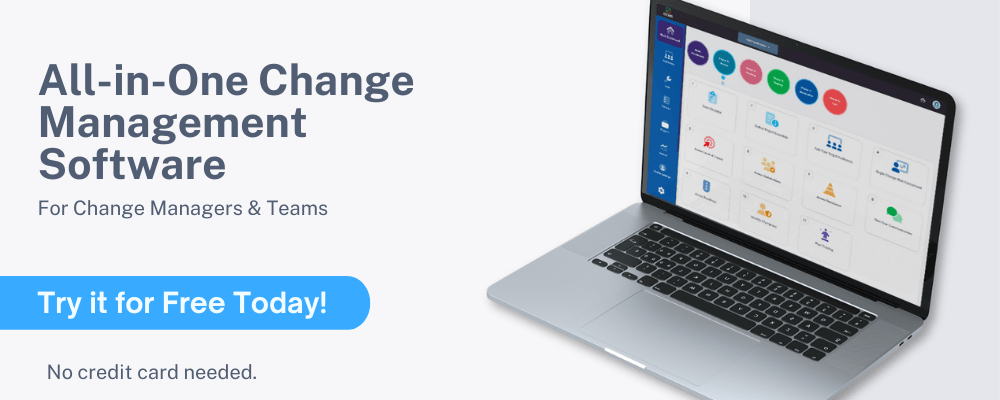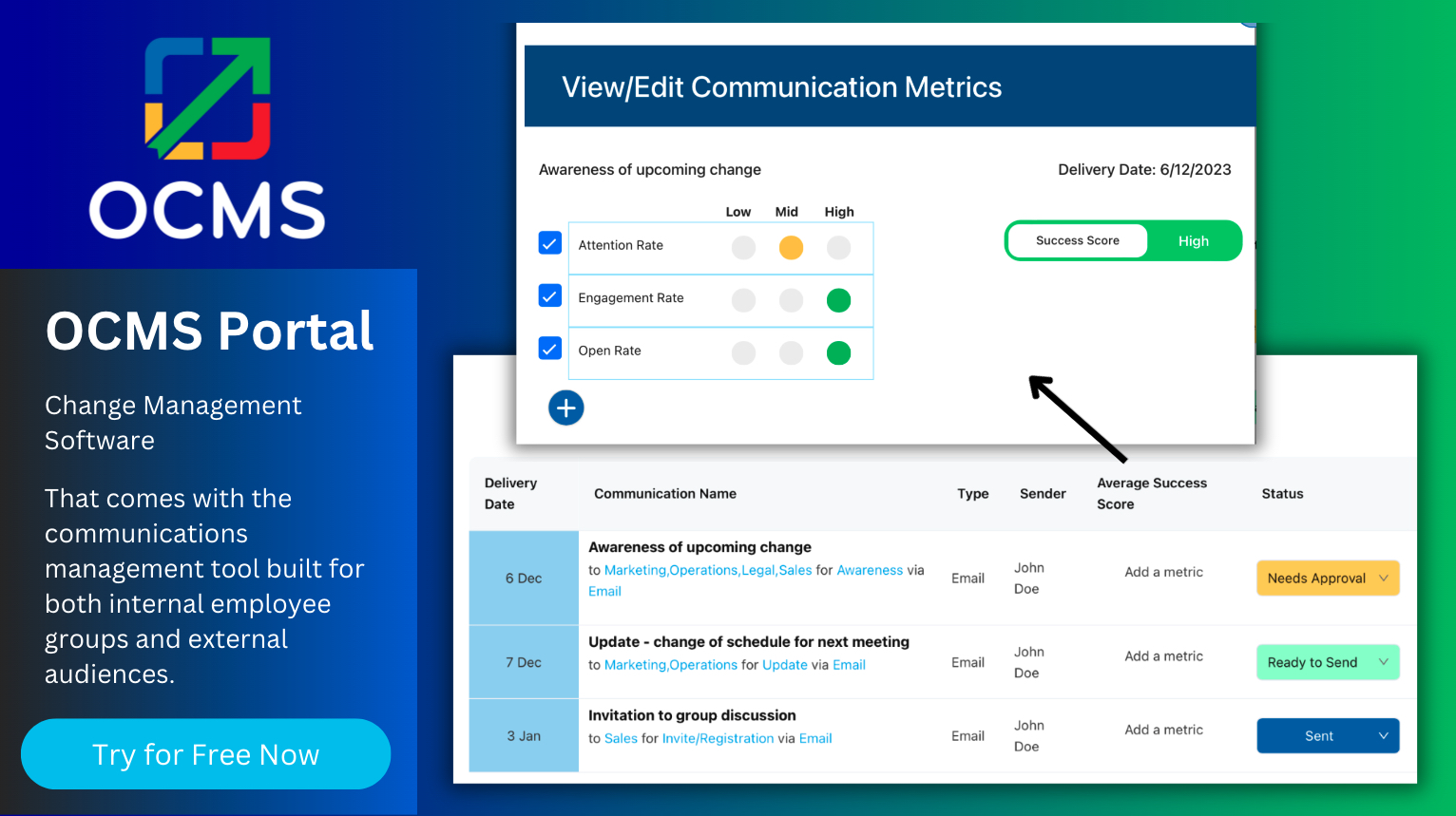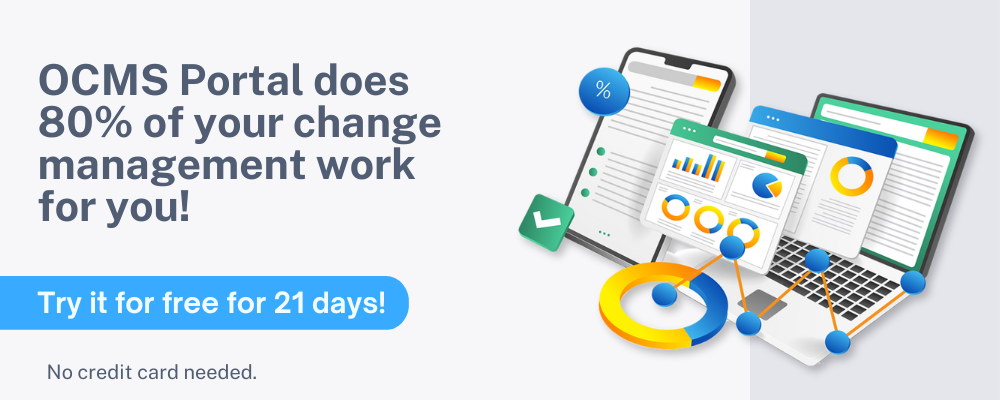Internal and External Communication – Best Strategies, Tips, and a Step-by-Step Plan
 Unlocking the Power of Effective Communication. But what is internal and external communication all about?
Unlocking the Power of Effective Communication. But what is internal and external communication all about?
Communication is the lifeblood of any successful enterprise. It’s the glue that holds teams together, fosters understanding, and keeps external stakeholders engaged. It’s not just about talking; it’s about connecting, aligning, and ultimately achieving your goals.
In this guide, we’ll take you through the ins and outs of both internal and external corporate communication. From understanding the nuances and the difference between internal and external all the way to nailing down success metrics and tracking your progress.
We believe that effective communication is a superpower, and by the end of this journey, you’ll have the tools to wield it masterfully.
So, get ready to dive in, learn, and grow. Whether you’re looking to improve workplace relationships, enhance your marketing efforts, or simply become a more effective communicator, you’re in the right place. Let’s embark on this exciting adventure together!
Seeking a snapshot summary? It’s coming up next. But if you’re eager to explore further and see external and internal communication examples, we have plenty of content ahead.
Quick Summary
Mastering Internal and External Communication Planning for Success
Effective internal and external communication planning is crucial for the success of a business. Internal communication involves both informal day-to-day interactions between departments and formal communication needed during projects or important announcements.
Managers must engage with both internal and external contacts to provide vital information and maintain operational efficiency. Tracking and organizing these communications in a management tool is essential to ensure they meet their intended objectives, as they can significantly impact the success or failure of a project or marketing initiative.
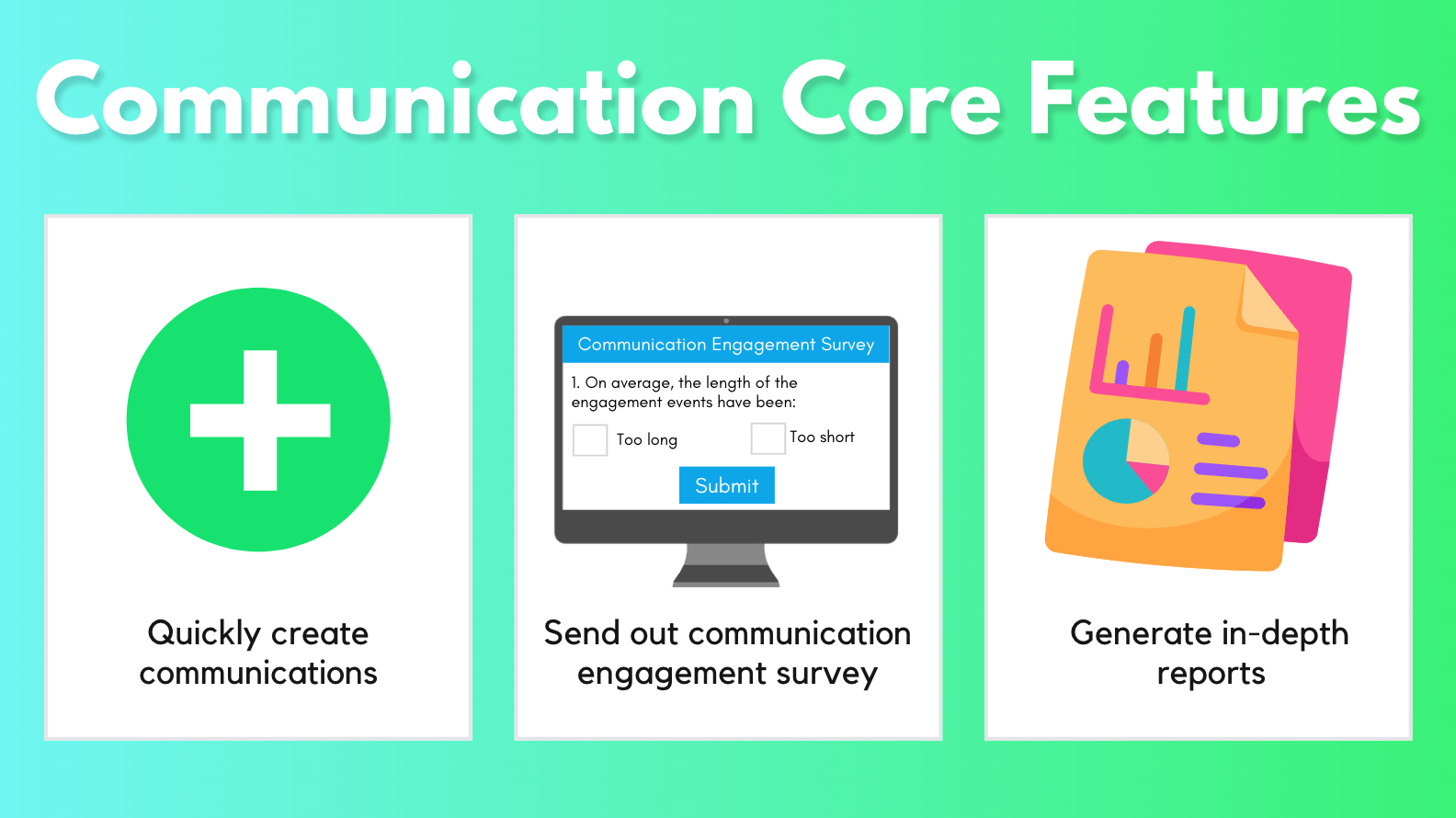
Are you tired of managing multiple clunky internal and external communication plans in Excel? Then it’s time to try out OCMS Portal. This All-in-one OCM solution includes the Communications Tool for seamless and comprehensive internal and external communication planning, among other tools to ensure your change management success. Sign up for free today (no credit card required).
Internal vs. External Communication: Understanding the Contrasts
Internal and external communication differ in various aspects, primarily in terms of their goals, audience, and confidentiality.
- Audience: Internal communication uses a team-oriented language (“we” and “us”) when addressing employees within the organization. In contrast, external communication focuses on what the company can offer to external groups and often adopts a more formal or promotional tone.
- Goals & Objectives: Internal communication aims to ensure the smooth functioning of operations and a high-performing team. External communication typically focuses on goals like increasing revenue and enhancing brand recognition. In some cases, both internal and external communication may share objectives, such as when a company initiative affects both groups, requiring communication to both internal and external stakeholders.
Change managers must communicate with internal and external contacts about the changes happening as a result of the initiative.
- Confidentiality: Internal communication is often confidential, intended only for internal consumption within the organization. In contrast, external communication is typically public and intended for external groups, such as customers, suppliers, or the general public.
Understanding these distinctions is crucial for tailoring communication strategies to effectively reach and engage both internal and external stakeholders.
The Significance of Internal and External Communication in Organization
Effective internal and external communication is vital for the smooth operation of an organization, as miscommunication can lead to mission failure and financial losses.
To prevent these issues, both internal and external communication should be:
- Timely
- Clear
- Goal-oriented
- and Properly tracked.
This ensures that messages are delivered as planned and achieve their objectives, safeguarding the organization against the consequences of ineffective or insufficient communication.
Crafting an Effective Internal and External Communication Strategy
Creating an internal and external communications strategy involves several key steps:
- Define Objectives: Clearly outline the purpose of your communication strategy, whether for internal projects or external announcements, specifying your goals.
- Assess Target Audience: Identify and evaluate internal and external target groups, tailoring your messages and channels to address their specific needs.
- Choose Communication Channels: Select the most suitable communication channels based on your target audience analysis, utilizing multiple platforms for effective reach.
- Craft Message Content and Assets: Develop engaging message content and visuals tailored to different audience segments, ensuring messages are well-received.
- Establish Trackable Metrics: Define metrics for measuring communication success, such as clicks, likes, and shares, enabling you to assess the effectiveness of messages and channels.
- Implement a Software/Tool: Organize your communication plan in a management software or tool for efficient tracking, prioritization, and monitoring of message delivery.
- Key Tracking Elements: Use various columns in your management tool to record campaign names, message priorities, audience details, message statuses, delivery channels, message specifics, and success metrics, as well as track important dates for an organized and efficient plan.
Following these steps will help create a comprehensive and effective internal and external communication strategy and help shape what an internal and external communication should be.
The OCMS Portal change management provides support for metric success scoring on communication campaigns. Use the built in communication metrics or customize your own. Try all of this for free today (no credit card needed).
Enhancing Communication: The Importance of Success Metrics
Establishing success metrics for communication is crucial because they not only define internal and external communication but also help to avoid project failures caused by poor communication.
These metrics are essential for gauging the effectiveness of communication channels based on the communication’s objectives and delivery method, and they play a critical role in helping to explain the importance of regular communication in the development of both internal and external communication. They enable real-time adjustments, ensuring messages meet their goals and effectively deliver clear communication with internal and external stakeholders.
Detailed Deep Dive
Everything You Need to Know: Best External and Internal Communications Guide & Plan
In this guide, we explain internal and external communication and how to plan a communication strategy. We’ll define internal and external communication, look at the difference between internal and external stakeholders, and explore internal vs external communication channels.
We also explain the importance of regular communication in the development of both internal and external customer relationships. Read on for all this and a step-by-step internal and external corporate communication strategy.
Sample Internal & External Communication Template Schedule
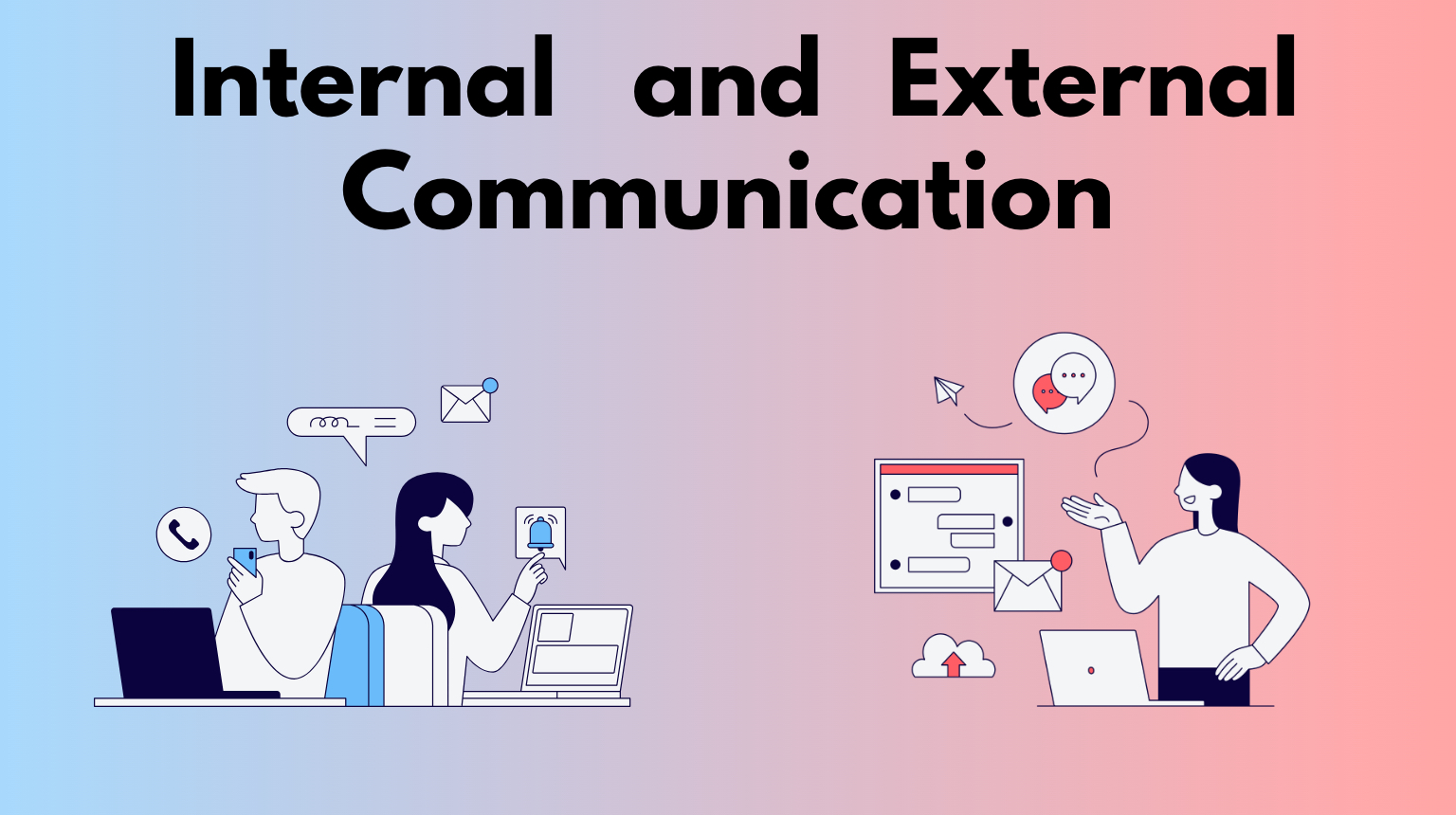
Internal and External Communication in Business
The Importance of Internal and External Communication Planning (& How to Do It)
First, let’s start out with why these types of communications are important. You can use this information when making your case with your management or stakeholders on the need for an effective communication program.
Internal and external business communication happens every day. There are informal communications between departments discussing normal day-t0-day activities. There are also more formal types of communication, internal and external, that are needed during a project or when making an important announcement.
Managers must communicate with internal and external contacts to answer questions, provide important information, and ensure that operations stay on track.
The internal and external communication examples that need planning are those that are more project, news, or marketing related. Such as when an organization is going through a merger or a change due to a project. Or when planning a digital marketing campaign.
These types of internal and external communication should be planned out and tracked in a communication management tool to ensure they’re meeting their desired goals. The internal and external communication strategies you carry out can often mean the success or failure of a project or marketing initiative.
Table of Contents: Internal vs External Communication Guide
Keep on scrolling down this page to read each section or click any link below to go directly to that section.
1. What Is Internal and External Communication?
2. What’s the Difference Between Internal and External Communication?
3. What Is External and Internal Communication Importance in an Organization?
4. What’s the Difference Between Internal and External Stakeholders?
5. Typical Internal and External Channels of Communication
6. Internal and External Communication Examples
7. Step-by-Step: How to Create an Internal and External Communications Strategy
a. Understand the Objective of the Internal and External Communications
b. Do a Target Audience Assessment
c. Decide on Internal and External Channels of Communication
d. Create Your Message Content & Image Assets
e. Determine Trackable Message Success Metrics
f. Enter Your Internal & External Communication Plan in a Software / Tool
g. Monitor & Optimize as You Deploy Your Communications Plan
8. Why You Should Define Internal and External Communication Success Metrics
9. OCMS Portal Internal & External Communication Toolkit (Template, Analytics, Checklist)
10. Conclusion – Top Guide for Internal and External Communication in an Organization
11. FAQ | What is External and Internal Communication?
Do you have any questions about the importance of internal external communication in an organization or about this guide? Please, reach out and let us know.
What Is Internal and External Communication?
To start, we’ll explain internal and external communications in an organization. All companies need to communicate various information to those that are considered employed by or “inside” the organization.
Companies also need to communicate information to outside, or external, groups. These may be customers, affiliates, suppliers, shareholders, contractors, and other outside entities.
Internal and external communication strategies provide structure and purpose for all the various types of communications being done by a company in the course of business.
Communication with internal and external stakeholders can include updates to shareholders, awareness communications about an upcoming transition, and much more. In this guide, we’ll explore several internal and external communication examples.
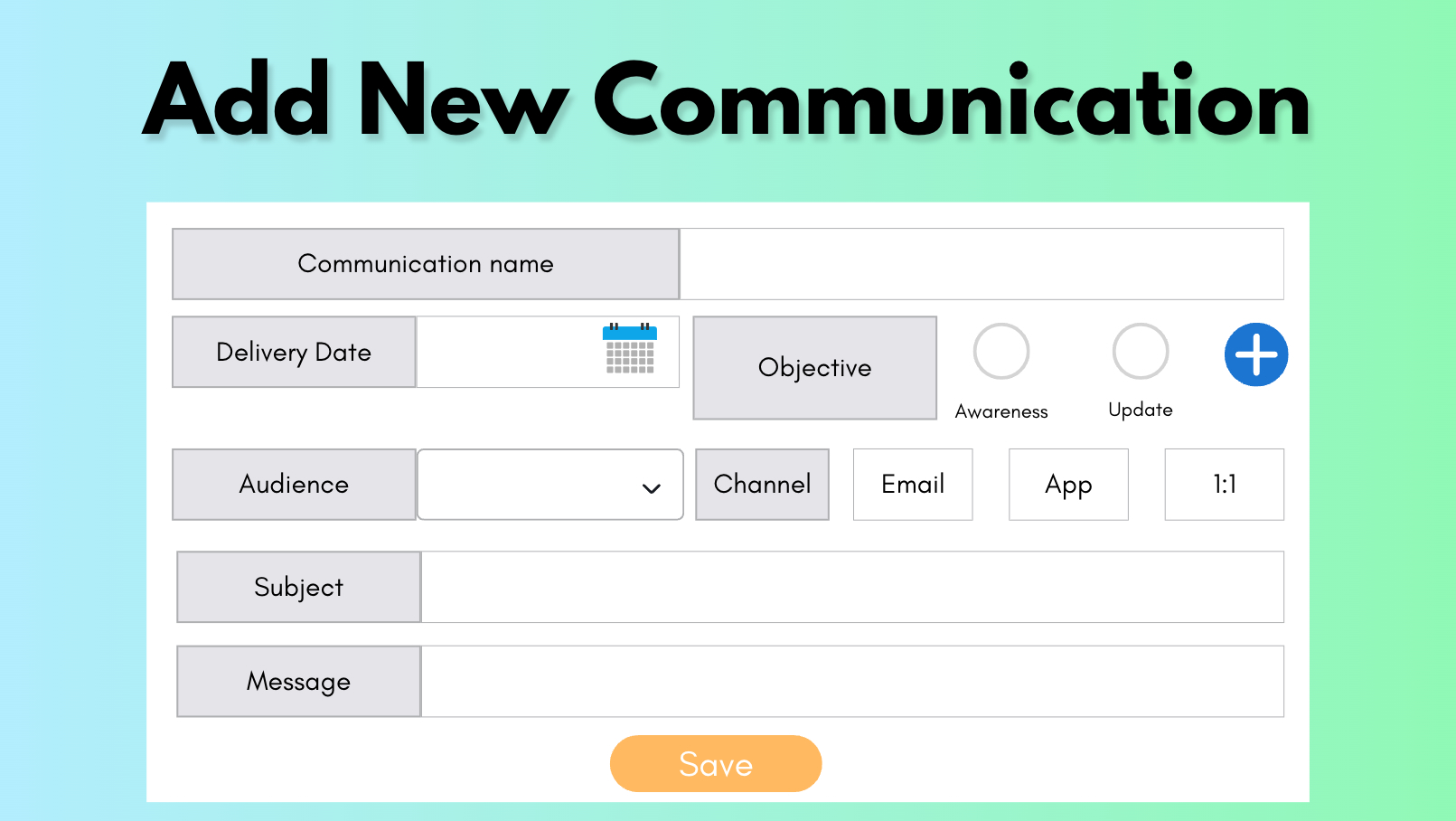
Looking for a great place to track and manage communication with internal and external stakeholders? Find out more on the OCMS Portal Internal & External Communication Management Toolkit.
What’s the Difference Between Internal and External Communication?
Internal communication and external communication will typically have different goals. The audience is also a factor that differentiates how internal and external business communication is handled.
Below, we’ll explain internal and external communication key differences.
Audience
When creating different types of communication, internal and external, companies will use a different “voice” when speaking with internal vs external audiences.
Communications for internal audiences will typically use “we” and “us” and be very team-oriented. Whereas messaging for external audiences will focus on what the company can do for an external group and/or typically be more formal or promotional in tone.
Goals & Objectives
The importance of internal and external communication goals is seen in how well a message hits its mark. That mark can differ widely between internal vs external communication audiences.
For example, common goals when communicating with external audiences is to increase revenue and brand recognition. However, goals for an internal communication audience may be to ensure smooth operations and a high-performing team.
One of the internal and external communication examples where an objective may be similar for internal and external stakeholders is when a company initiative is impacting both. In this case, change managers must communicate with internal and external contacts about the changes happening as a result of the initiative.
Confidentiality
Internal and external communication in business have another big difference, which is in the confidentiality of those communications. Most of the time, communications to external groups are public. Often, communications with internal groups are confidential and not meant to be shared outside an organization.
Do you have any questions about what the difference between internal and external stakeholders is? Do you have other examples of internal external communication variations? Reach out and let us know.
What Is External and Internal Communication Importance in an Organization?
Internal and external corporate communication is necessary for an organization to run effectively. Miscommunication can cause mission failure and result in revenue loss.
The following statistic helps to explain the importance of regular communication in the development of both internal and external customer relationships.
According to “The Cost of Poor Communications” study, which surveyed 400 organizations that had 100,000 employees or more, the average loss per company for inadequate communications was $62.4 million annually.
Additionally, 86% of executives and employees say that a lack of effective communication and collaboration is the main cause of workplace and project failures.
Internal and external communication should be timely, clear, goal-based, and tracked appropriately to ensure messages are sent out on schedule and meet their goals. This helps ensure that the organization doesn’t suffer due to ineffective or insufficient messaging.
Looking for Simple & Effective Internal & External Communication Tools?
Drive more effective internal and external communication strategies with the OCMS Portal Communications Management Tool.
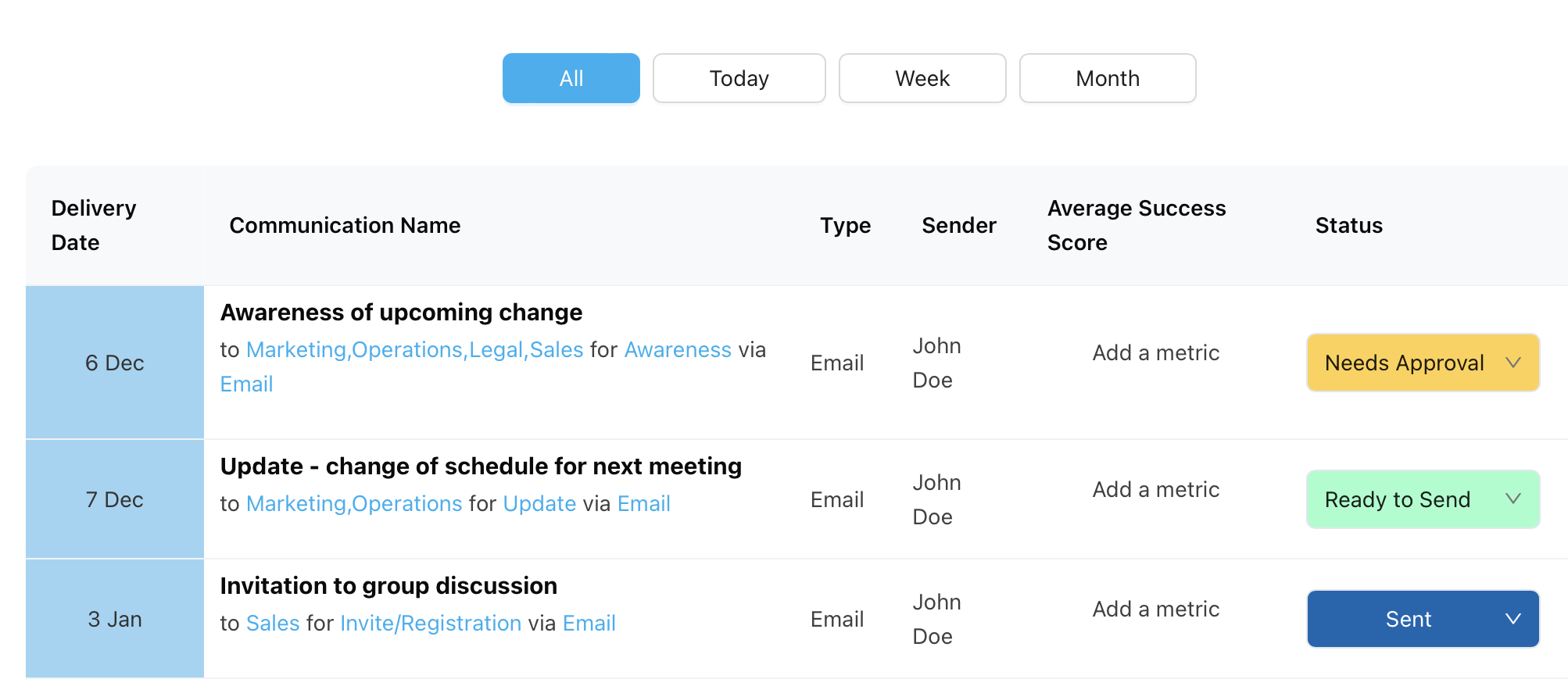
The delivery schedule tracks communication timing with internal and external stakeholders.
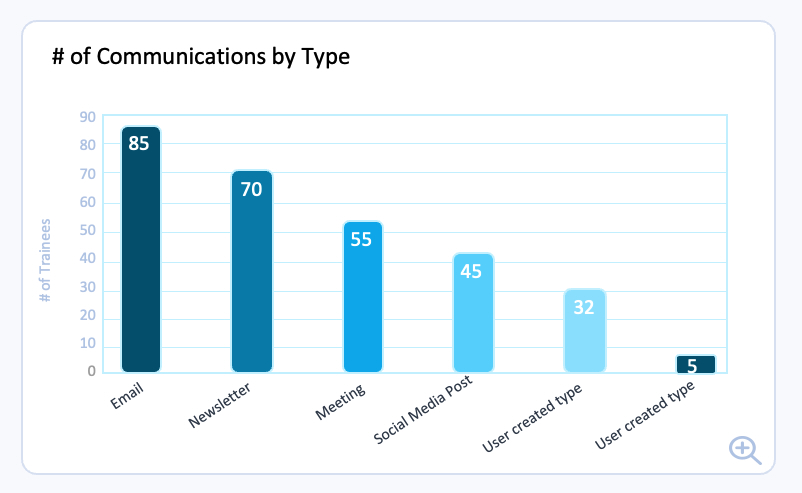
Get a full picture of both internal communication and external communication activities in a single place.
See the OCMS Portal Internal and External Communications Management Tool
Do you have any questions about this article on “what is internal and external communication” or the different types of communication internal and external? Reach out and let us know.
What’s the Difference Between Internal and External Stakeholders?
Stakeholders are groups of people with a vested interest in something. In the case of internal and external business communication, it would be in your business or in the thing you are communicating about.
For example, if a company was launching a project to change its customer ordering process, this change would impact both internal and external stakeholders.
Employees would need to adjust on the internal side to the new process, and customers would also need to know what was changing in how they place orders. In this case, change managers must communicate with internal and external contacts about the changes.
In the case of a marketing campaign, the stakeholders involved would be external groups – or those the company was making aware of its offerings.
The difference between internal and external stakeholders is simply that internal are stakeholders inside a company (employees, managers, departmental groups, etc.). External stakeholders are those that are outside the company (vendors, contractors, customers, shareholders, etc.)
Do you have any questions about the customer relationships? Please reach out and let us know.
Typical Internal and External Channels of Communication
Internal and external channels of communication can overlap between both communication groups. For example, email is one of the types of communication internal and external stakeholders will both have sent to them.
Online advertising, on the other hand, is a channel usually only used for external company communications. Similarly, an internal Microsoft Teams channel would be commonly used for internal communications within the organization only.
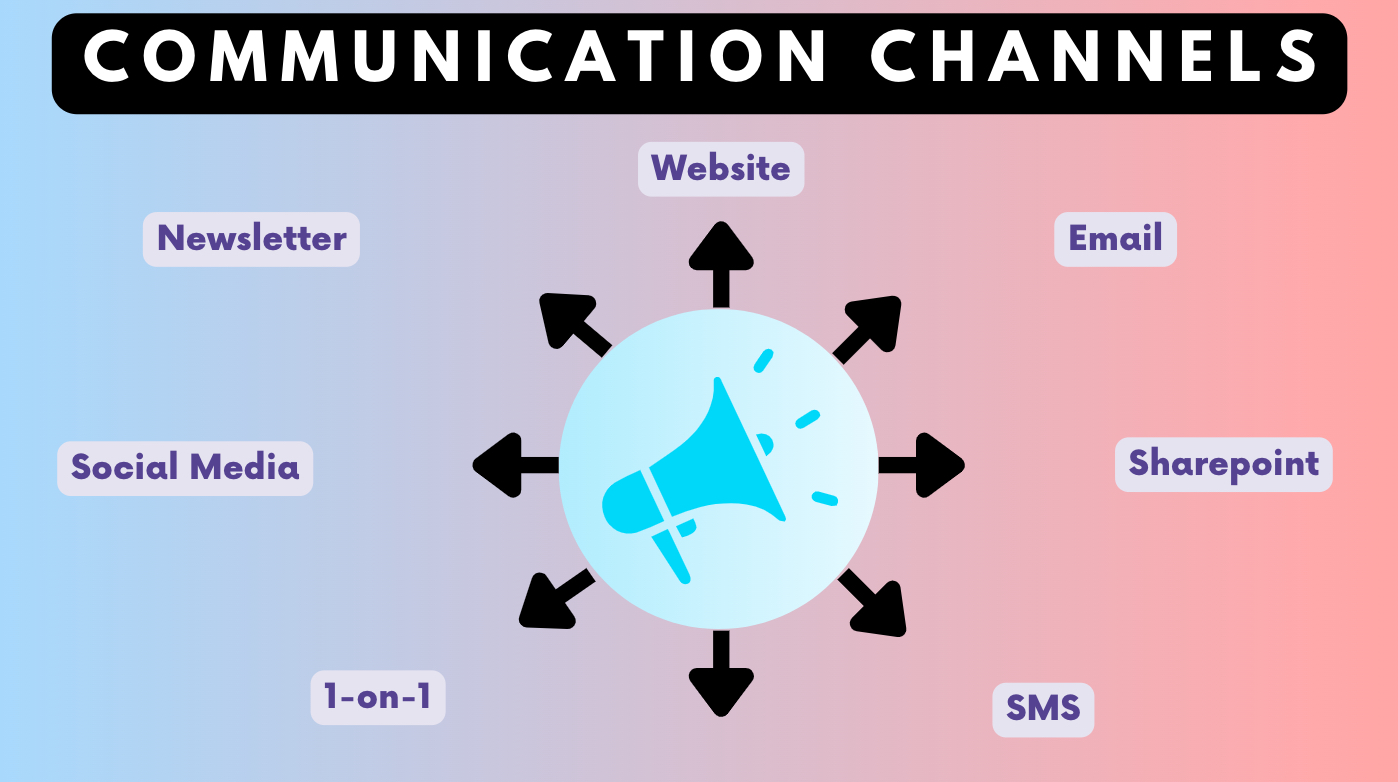
Here are a few of the typical internal external communication channels used for various types of messages:
- In-person meetings
- Virtual meetings
- Newsletter
- Website
- SharePoint site
- Video
- SMS/text
- 1-on-1 meetings
- Social media
- Phone calls
- Company blog
- Pay-per-click advertising
- Direct mail
- Webinar
What types of internal and external channels of communication do you find most effective? Share your thoughts and we’ll include them in the list!
Internal and External Communication Examples
When planning your internal and external communications strategy, it helps to have examples of the types of communications that are typically sent out for these groups.
If using a tool or communication software for managing internal and external corporate communication, you may be lucky enough to have examples within that tool. Such as the OCMS Portal Communications Tool, which includes both internal and external communication examples and sample data.
See sample data for internal vs external communication campaigns in the OCMS Portal communication tool.
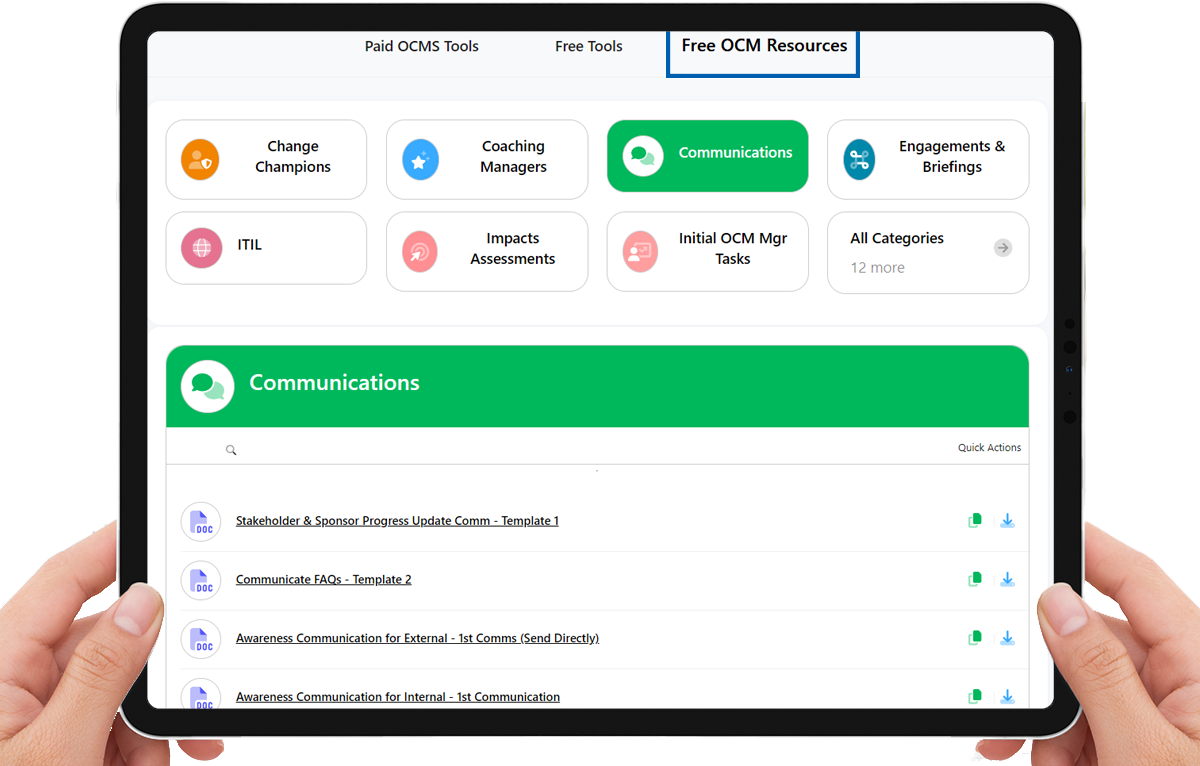
Why does OCMS Portal include realistic sample data in its software tools? Because we understand the importance of internal and external communication and want to give you every tool we can to succeed.
What is internal and external communication usually sent out for?
Examples of internal communications:
- Change management for company groups impacted by a project
- Human resources information
- Company news updates
- Company policy updates
- Employee onboarding and training
- Scheduling
- And many more…
Examples of external communications:
- Change management for external groups impacted by a project
- Marketing/sales advertising
- Public company updates
- Shareholder updates
- New product/service announcement
- And many more…
Would you like to see more internal and external communication examples? Check out the OCMS Portal Communication Management Toolkit.
Step-by-Step: How to Create an Internal and External Communications Strategy
When creating a strategy for a communication campaign, the difference between internal and external communication is mainly just in the channel and message, the steps you take for planning will be the same.
Whether you are planning an external marketing campaign to drive leads to your website or are a change agent creating an internal and external communications strategy, you can use the guide below.
These steps for developing internal and external communication strategies will help you with an outline that you can use for future communication planning for all kinds of purposes.
Understand the Objective of the Internal and External Communications
To communicate with groups effectively, you should fully understand the objective of the internal and external communications strategy. Is this a project impacting internal groups? Does the company need to announce an expansion to shareholders?
Discuss in detail the objective and importance of internal and external communication for the project/news/initiative with the people driving the need for the comms campaign.
The person driving the reason for the communications may be a project manager, change manager, marketing director, department head, investor relations department, or another person or group.
The better you understand the reason communication is needed and the goals it should achieve, the more on-point your internal and external business communication strategy will be.
Do a Target Audience Assessment
When speaking with the person/group driving the reason for the comms campaign, you’ll learn about the types of groups to which you’ll need to direct internal communication and external communication. Next, you should clearly identify them by doing a target audience assessment.
A target audience analysis is where you drill down to identify the target audiences for your communications strategy. These would be the specific internal and/or external groups that are either being impacted by a project, that are included in company news being sent out, or that are prime targets for a marketing campaign.
Often, you need to send slightly different messages and may need to use specific communication channels depending upon the difference between the internal and external stakeholders (audiences) being communicated with.
Need a tool to do a target audience analysis? We’ve built the target audience into the heart of our OCM software. Check out our All-in-One solution with the Target Audience right at the center.
Decide on Internal and External Channels of Communication
Use the details from your target audience assessment, which will include the best channels for communicating with an audience, to set your channels. It’s recommended to use at least four different communication channels when you are going to be sending several messages over several weeks to a group.
Using different channels for your internal external communication campaigns will help your message be seen and remembered better than using only one channel.
Note which channels your team will need to facilitate, so you can put things in motion now to make sure they’re ready when it’s time to send the external and internal communication messages. (For example, if you’re using a SharePoint site, make sure it’s set up and accessible to your target audience group.)
Create Your Message Content & Image Assets
The importance of external communication messaging can’t be stressed enough. You need to understand your target audiences so you can speak to them effectively when putting together external business communication campaigns.
Your next step in this external comms plan is to look at the external communication meaning for each audience group. Refine the message to speak to each one. In most cases, you won’t want to send the same exact message to vastly different external audiences.
Use this information to develop the message content and images that make up the communications. These will need to be drafted, reviewed, and approved.
Determine Trackable Message Success Metrics
How do you know if an internal and external communications strategy is successful? Is it the number of people that clicked a link to sign up for a webinar? Maybe it’s the number of likes and shares for a social media messaging campaign?
It’s important to track the success of a message, so you can learn from reviewing your internal vs external communication analytics which messages or channels are working and which are not.
We will delve more into this topic in the next section.
Enter Your Internal & External Communication Plan in a Software / Tool
What is external and internal communication that isn’t organized? It’s often ineffective and can fail to meet objectives. This is why you need to secure a communications management software, spreadsheet, or another tool for entering all the details of your internal and external communications strategy.
Inputting your internal communication and external communication plans into software or another tool allows you to easily track comms, prioritize them, and see when messages are late going out. You can also input metrics of success and measure these.
What Internal External Communication Details Should you track?
Here are some of the columns you’ll want to use or create in your communications management tool:
- Name of the communication campaign
- Message priority
- Communication type
- The audience for the message (it’s best to track these on separate rows)
- Status of the message (being drafted, needs approval, etc.)
- Delivery channel
- Message details (like the subject line)
- Metrics for measuring the success of the messaging
- Success level for the communication
- Start, end, and sent dates
OCMS Portal Template & Toolkit for Managing External and Internal Communication Campaigns
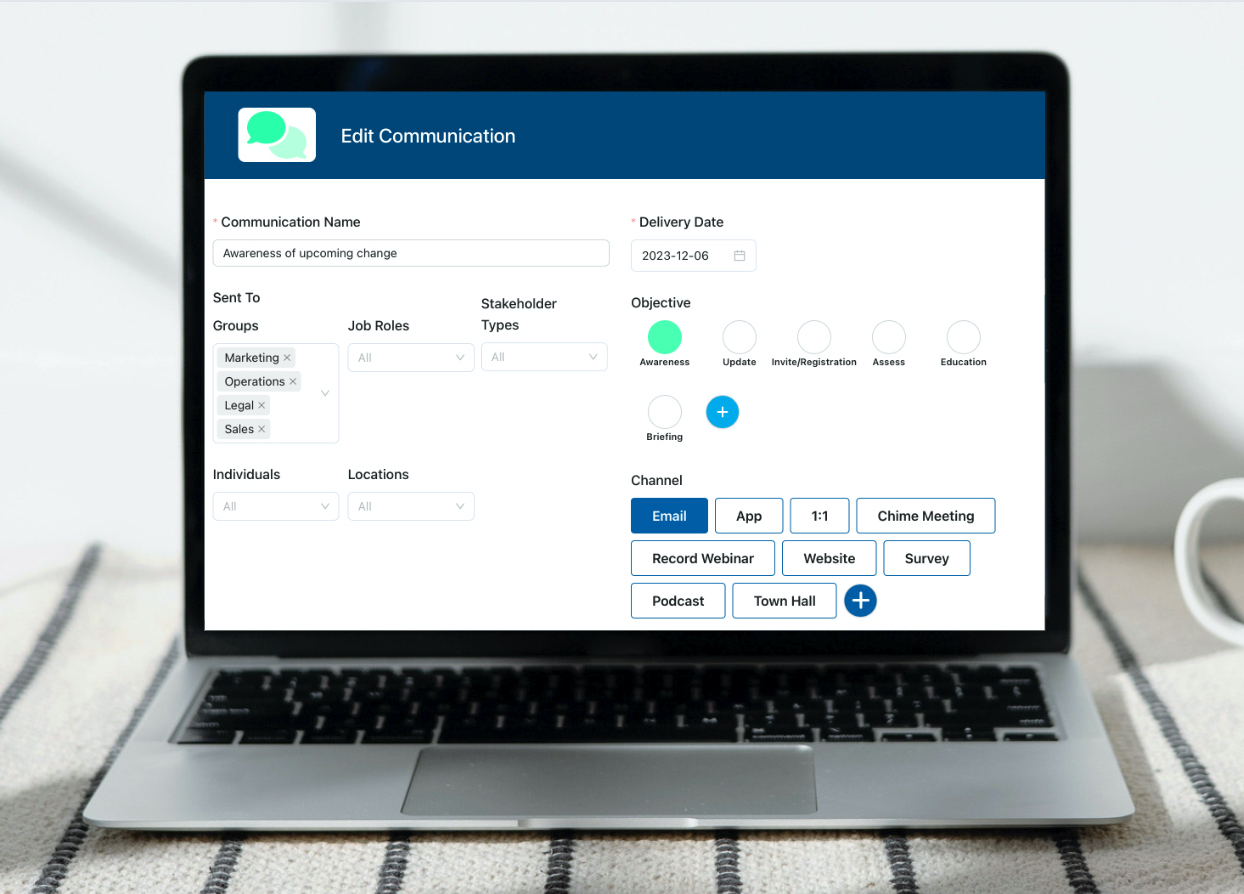
Whichever communication management tool you choose to use, you should ensure that it has an analytics reporting dashboard. This will save you time and give you reporting to share with others that are interested in the success of the communications strategy.
Monitor & Optimize as You Deploy Your Communications Plan
As you begin sending out the messages in your internal and external communication strategies, you should track the success of your campaigns. Are recipients taking the desired actions? Gaining the intended awareness? Reacting in the way you wanted, such as contacting your company?
If the communications management tool you chose has reporting, then you can easily monitor your campaign message success, and optimize your campaigns as they’re being deployed.
Why You Should Define Internal and External Communication Success Metrics
Many projects and initiatives fail because of poor communications. Internal stakeholders may not have learned what they needed to about a new process. External groups might complain about a change in policy that they never remembered being told about in advance.
How do you know if a particular communication channel isn’t reaching the intended audience? You track success metrics.
The metrics you track will depend on the objective of the communication and the delivery channel. For example, if the delivery channel for a message is a live webinar, if you have a lot of people signing up from your communication, you know it was successful.
However, if you send out an email internally asking people to fill out a form for upcoming training, and hardly anyone does, you know you have a problem.
The difference between internal and external communication that meets goals and those that fall short is often being able to identify, as messages are going out, what’s working and what’s not. You need tracking metrics in place to do that.
Internal and External Communication Examples of Tracking Metrics from OCMS Portal
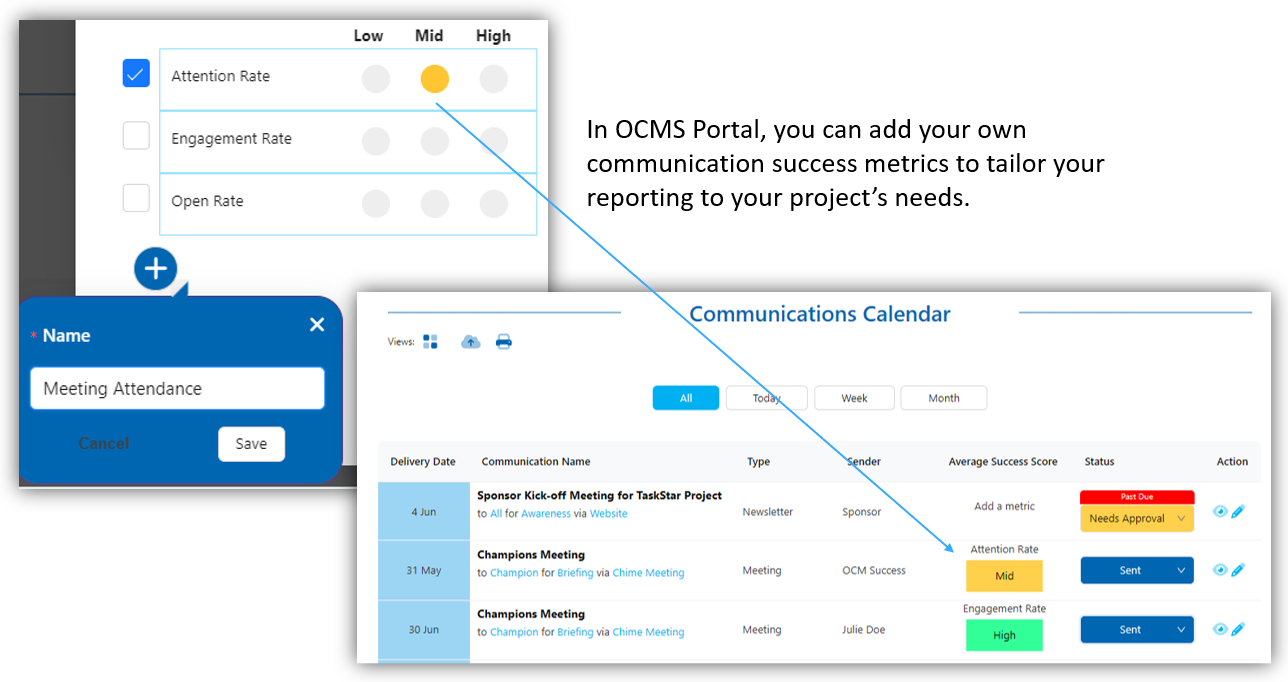
This sample data from the OCMS Portal Communication Management Software gives users several ideas for how they can track success metrics for communication with internal and external stakeholders.
Is there a best internal and external communications strategy that you have used that you would like to share with other project managers and change leads? Please, reach out and let us know.
OCMS Portal Internal & External Communication Toolkit (Template, Analytics, Checklist)
Would you like to know more about the OCMS Portal Communications Management Toolkit described on this page?
This simple and flexible toolkit includes everything you need for managing internal and external communication in business. Once you sign up, the toolkit is ready to use immediately, and your first project is created for you automatically to save you time.
The OCMS Portal Communications Management Platform includes:
- Template: Customizable template to input the details of your communications
- Analytics: 360-degree analytics reporting dashboard
- Checklist: Bonus communications planning checklist
- Video tutorial, guide, and more
Take a look at the OCMS Portal tool now by visiting this page.
Simplify Internal Communication and External Communication with OCMS Portal
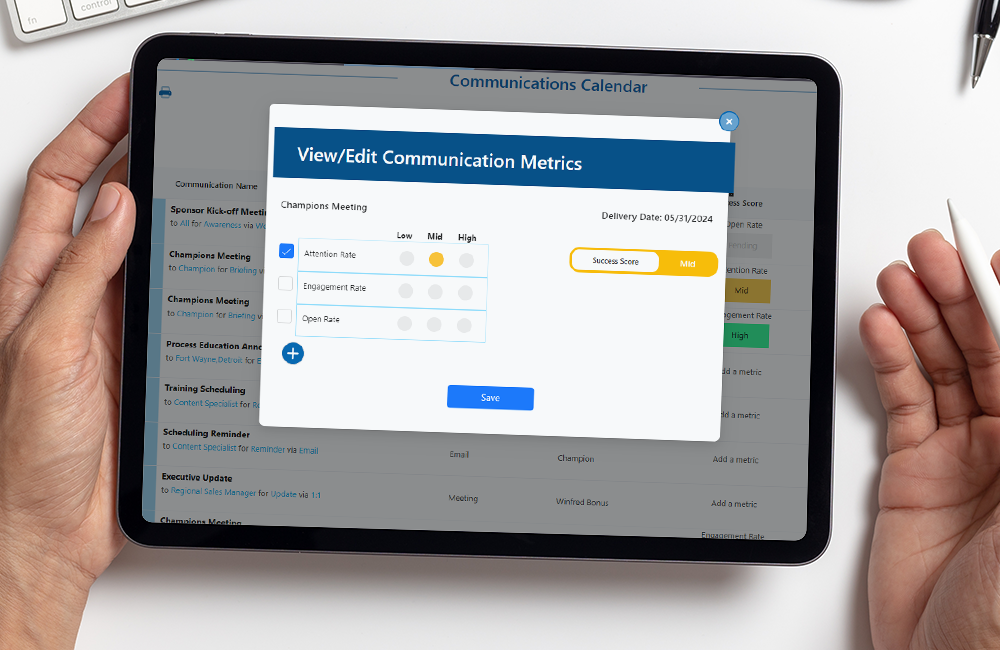
► ► Best External and Internal Communication Mgt Tool
Do you have any questions about the difference between internal and external stakeholders or this article on what is external and internal communication? Please reach out and let us know.
Conclusion – Top Guide for Internal and External Communication in an Organization
The difference between internal and external communication is dictated by the audience that is receiving the communication and the purpose of the messages.
When it comes to planning your internal and external communication strategies, you’ll be following the same steps for internal and external audiences. The keys to a successful communications campaign are fully understanding the objectives for the communications, identifying the right audiences, and managing and monitoring your campaigns.
Communication management tools can help run more successful external and internal communication campaigns. This is especially true if they have robust reporting analytics that you can use to see what’s going well and what needs to be improved.
Please don’t hesitate to contact OCM Solution if you have any questions about internal vs external communication or the other information you found in this guide. We wish you the best in deploying your communication strategies.
FAQ | What is External and Internal Communication?
Internal communications are sent to groups inside an organization, such as employees and leadership. External communications are sent to groups outside an organization, such as shareholders and customers.
There is a difference between internal and external communication. Internal communications are sent within an organization to those working there. Examples of internal communications are:
External communications are sent to groups outside a company. Examples of external communications include:
There are several different messages that leaders, project leads, marketing professionals, and managers must communicate with internal and external contacts. These communications include everything from marketing messaging to shareholder communications to change management communications. Internal and external corporate communication is necessary for an organization to run effectively. Miscommunication can cause mission failure and result in revenue loss. 86% of executives and employees say that a lack of effective communication and collaboration is a main cause of workplace and project failures. External image sources:What is the difference between internal and external communication?
What are types of internal communications?
• Change management for company groups impacted by a project
• Human resources information
• Company news updates
• Company policy updates
• Employee onboarding and training
• Scheduling
• And many more… What are types of external communications?
• Change management for external groups impacted by a project
• Marketing/sales advertising
• Public company updates
• Shareholder updates
• New product/service announcement
• And many more… Why is internal and external communication in an organization important?
Note: Content on OCM Solution's ocmsolution.com website is protected by copyright. Should you have any questions or comments regarding this OCM Solution page, please reach out to Ogbe Airiodion (Change Management Lead) or the OCM Solution Team today. OCM Solution was previously known as Airiodion Global Services (AGS).


